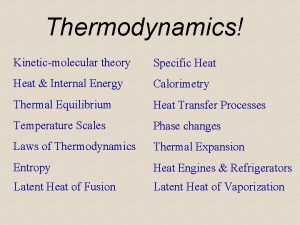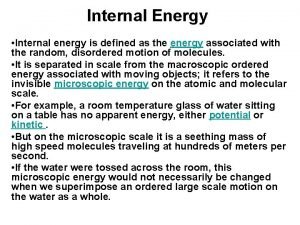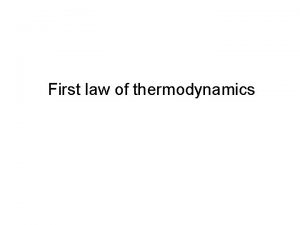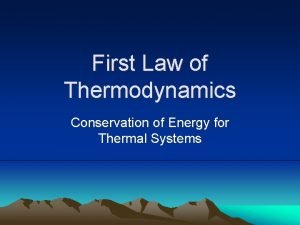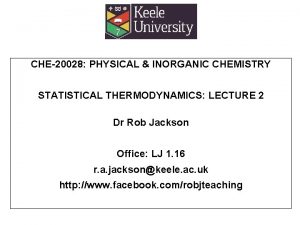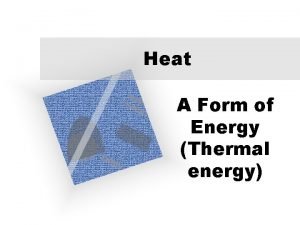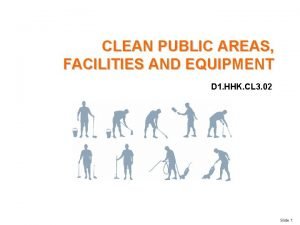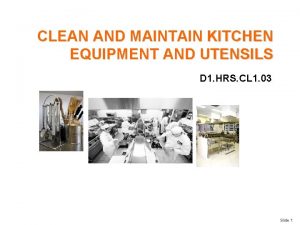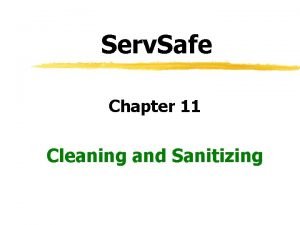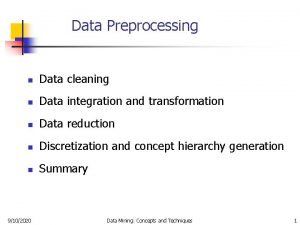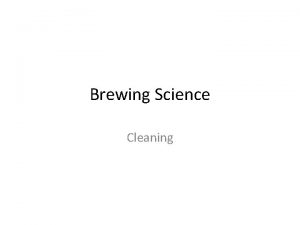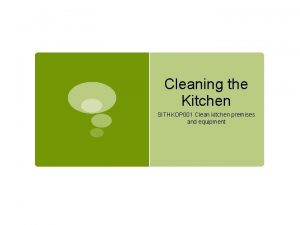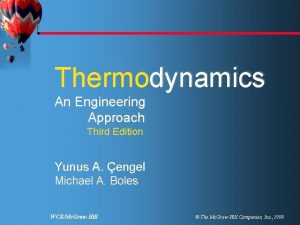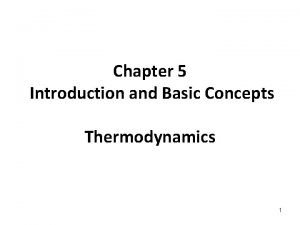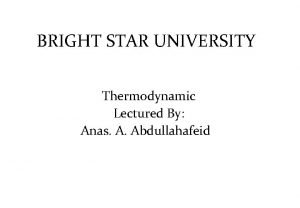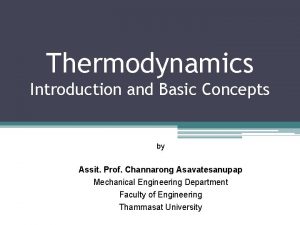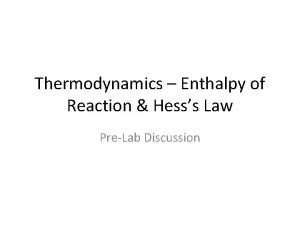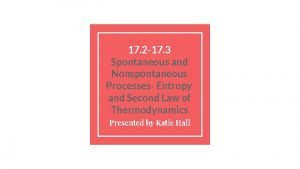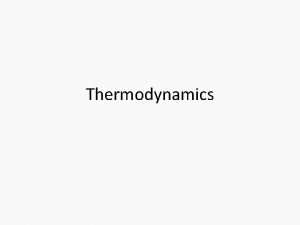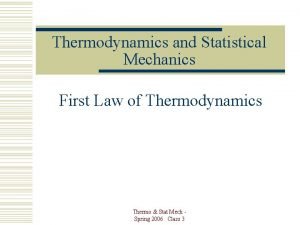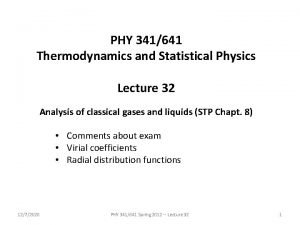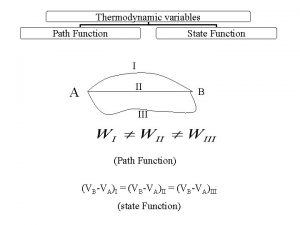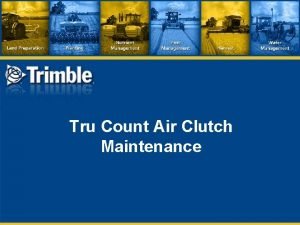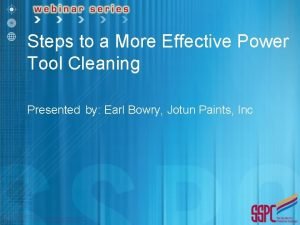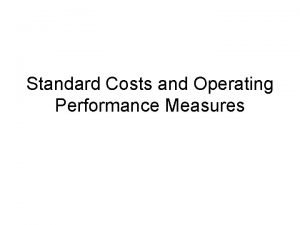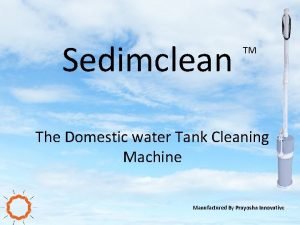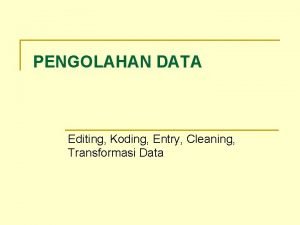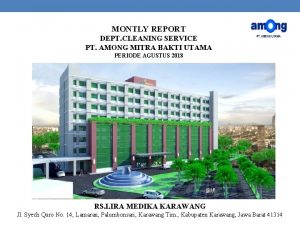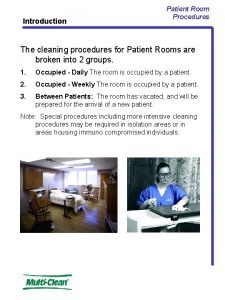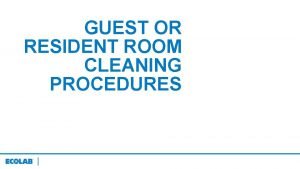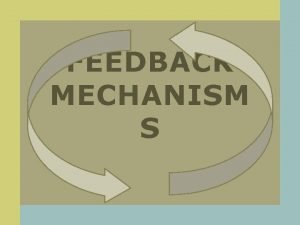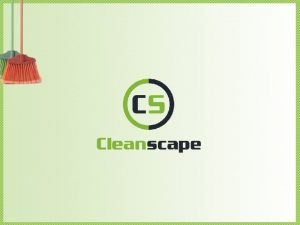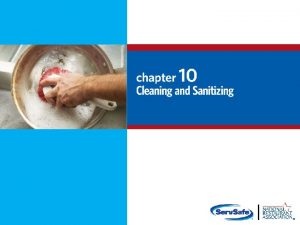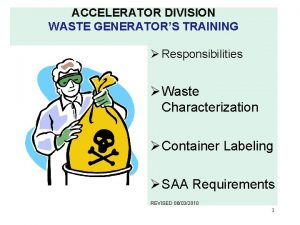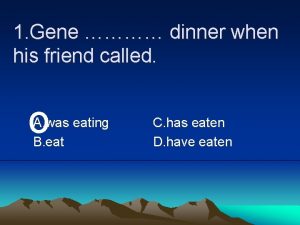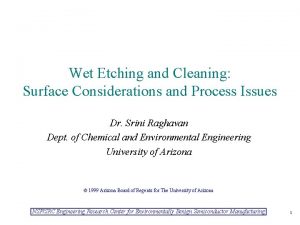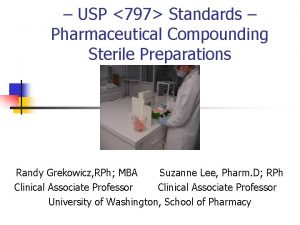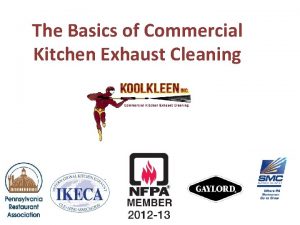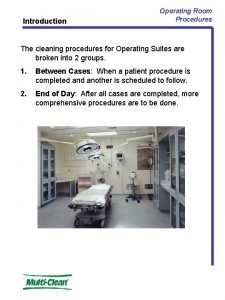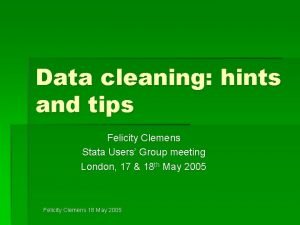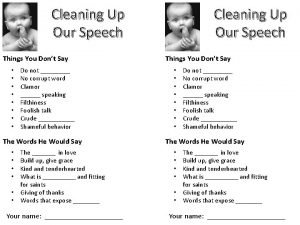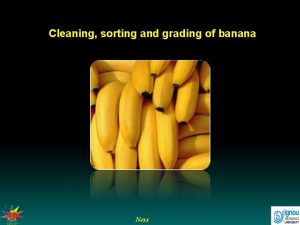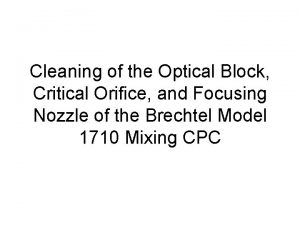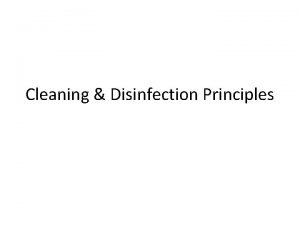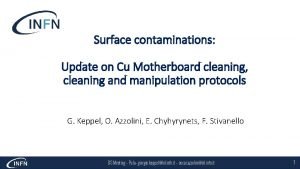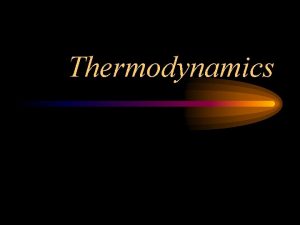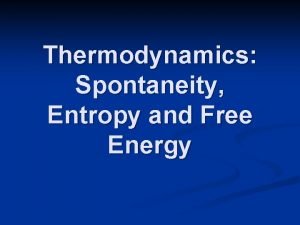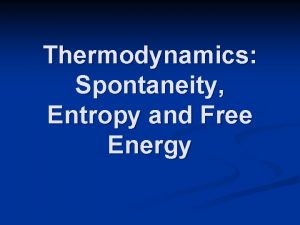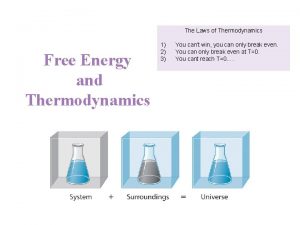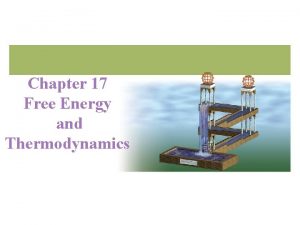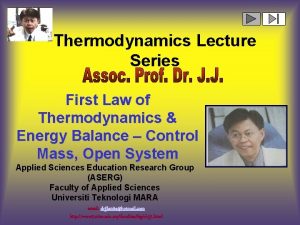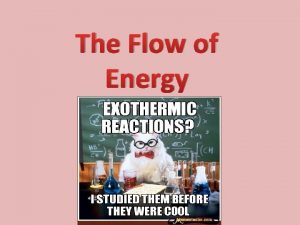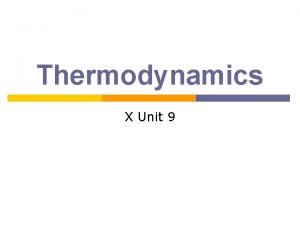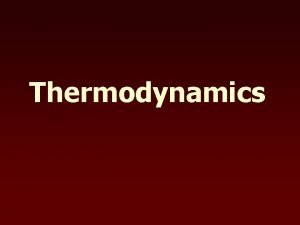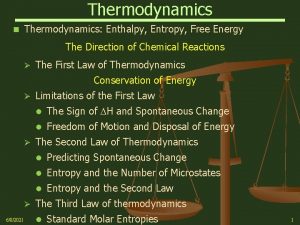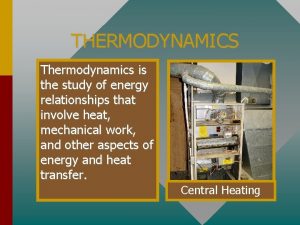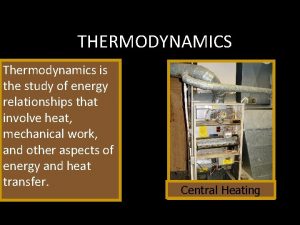Surface Energy and Surface Cleaning 1 Thermodynamics of































































- Slides: 63

Surface Energy and Surface Cleaning 1

Thermodynamics of Solid Surfaces In liquids shapes is governed by minimisation of the surface free energy (surface tension) In general droplets adopt a spherical geometry and display no directional dependence. 2

3

4

5

6

7

8

9

10

11

12

13

14

15

gas phase surface bulk Ab initio atomistic thermodynamics and statistical mechanics of surface properties and functions K. Reuter, C. Stampfl and M. Scheffler, in: Handbook of Materials Modeling Vol. 1, 16 (Ed. ) S. Yip, Springer (Berlin, 2005). http: //www. fhi-berlin. mpg. de/th/paper. html

Surface thermodynamics solid – gas solid – liquid solid – solid (“interface”) … A surface can never be alone: there always “two sides” to it !!! Phase I / phase II alone (bulk): Phase II (T, p) Phase I GI = NI I GII = NII II Total system (with surface): GI+II = GI + GII + Gsurf A = 1/A ( GI+II - i Ni i ) Surface tension (free energy per area) 17

Example: Surface in contact with oxygen gas phase surf. = 1/A [ Gsurf. (NO, NM) – NO O - NM M ] O 2 gas i) Use reservoirs: surface bulk i) O from ideal gas ii) bulk ii) M = g. M Forget about Fvib and Fconf for the moment: (slab) – N E bulk )/A – N (T, p) /A (T, p) ( Esurf. M M O O 18

Oxide formation on Pd(100) p(2 x 2) O/Pd(100) - clean (me. V/Å2) (slab) ( Esurf. – NM EMbulk )/A – NO O/A (√ 5 x √ 5)R 27° Pd. O(101)/Pd(100) M. Todorova et al. , Surf. Sci. 541, 101 (2003); K. Reuter and M. Scheffler, Appl. Phys. A 78, 793 (2004) 19

Vibrational contributions to the surface free energy Fvib(T, V) = d Fvib(T, ) ( ) 30 vib = Fvib/A = (me. V) = 1/A d Fvib(T, ) [ surf. ( ) - NRu bulk ( ) ] 20 Only the vibrational changes at the surface contribute to the surface free energy 10 0 Pd bulk Þ Use simple models for order of magnitude estimate e. g. Einstein model: ( ) = ( - ) Pd(bulk) ~ 25 me. V 20

Surface induced variations of substrate modes 20 vib (me. V/Å2) 10 + 50% 0 - 50% -10 -20 0 200 400 600 800 1000 Temperature (K) < 10 me. V/Å2 for T < 600 K - in this case!!! 21

Surface functional groups H 2 O vib. (me. V/Å2) 40 30 20 OH 10 0 0 200 400 600 800 1000 Temperature (K) 22 Q. Sun, K. Reuter and M. Scheffler, Phys. Rev. B 67, 205424 (2003)

(me. V/Å2) Configurational entropy and phase transitions clean surface x 1) No lateral interactions: Fconf = k. BT ln (N+n)! / (N!n!) 1. 0 < (O) > O(1 T = 300 K T = 600 K Langmuir adsorption-isotherm 0. 5 < (Ocus)> = 0. 0 -1. 5 1 -1. 0 O (e. V) -0. 5 1 + exp((Ebind - O)/k. BT) Configurational entropy smears out phase transitions 23

The Solid – Liquid Interface: 24

25

26

27

28

29

30

31

32

33

34

35

36

37

38

39

40

41

42

43

44

Reasons Why Parts Must be Cleaned • Prepare surface for subsequent processing, such as a coating application or adhesive bonding • Improve hygiene conditions for workers and customers • Remove contaminants that might chemically react with the surface • Enhance appearance and performance of the product

Factors in Selecting a Cleaning Method • • Contaminant to be removed Degree of cleanliness required Substrate material to be cleaned Purpose of cleaning Environmental and safety factors Size and geometry of the part Production and cost requirements

Contaminant to be Removed • Various contaminants build up on part surfaces, either due to previous processing or factory environment • Principal surface contaminants found in factory – Oil and grease, e. g. , lubricants in metalworking – Solid particles such as metal chips, abrasive grits, shop dirt, dust, etc. – Buffing and polishing compounds – Oxide films, rust, and scale

Degree of Cleanliness Refers to the amount of contaminant remaining after a given cleaning operation • A simple test is a wiping method, in which the surface is wiped with a clean white cloth – Amount of soil absorbed by the cloth is observed – Non‑quantitative but easy to use

Other Factors in Selection • The substrate material must be considered – So that damaging reactions are not caused by the cleaning chemicals • Aluminum is dissolved by most acids and alkalis • Steels are resistant to alkalis but react with virtually all acids • Cleaning methods and associated chemicals should be selected to avoid pollution and health hazards

Chemical Cleaning Processes • • • Alkaline cleaning Emulsion cleaning Solvent cleaning Acid cleaning Ultrasonic cleaning

Alkaline Cleaning Uses an alkali to remove oils, grease, wax, and various types of particles (metal chips, silica, light scale) from a metallic surface • Most widely used industrial cleaning method • Alkaline solutions include sodium and potassium hydroxide (Na. OH, KOH), sodium carbonate (Na 2 CO 3), borax (Na 2 B 4 O 7) • Cleaning methods: immersion or spraying followed by water rinse to remove residue

Emulsion Cleaning Uses organic solvents (oils) dispersed in an aqueous solution • Suitable emulsifiers (soaps) results in a two‑phase cleaning fluid (oil‑in‑water), which functions by dissolving or emulsifying the soils on the part surface • Used on either metal or nonmetallic parts • Must be followed by alkaline cleaning to eliminate all residues of the organic solvent prior to plating

Solvent Cleaning Organic soils such as oil and grease are removed from a metallic surface by chemicals that dissolve the soils • Common application techniques: hand‑wiping, immersion, spraying, and vapor degreasing – Vapor degreasing (a solvent cleaning method) uses hot vapors of chlorinated or fluorinated solvents

Acid Cleaning Removes oils and light oxides from metal surfaces using acid solutions combined with water‑miscible solvents, wetting and emulsifying agents • Common application techniques: soaking, spraying, or manual brushing or wiping carried out at ambient or elevated temperatures • Cleaning acids include hydrochloric (HCl), nitric (HNO 3), phosphoric (H 3 PO 4), and sulfuric (H 2 SO 4)

Acid Pickling More severe acid treatment to remove thicker oxides, rusts, and scales • Distinction between acid cleaning and acid pickling is a matter of degree • Generally results in some etching of the metallic surface which serves to improve organic paint adhesion

Ultrasonic Cleaning Mechanical agitation of cleaning fluid by high‑frequency vibrations (between 20 and 45 k. Hz) to cause cavitation (formation of low pressure vapor bubbles that scrub the surface) • Combines chemical cleaning and mechanical agitation of the cleaning fluid • Cleaning fluid is generally an aqueous solution containing alkaline detergents • Highly effective for removing surface contaminants

57

58

59

60

61

62

63
 Energy energy transfer and general energy analysis
Energy energy transfer and general energy analysis Energy energy transfer and general energy analysis
Energy energy transfer and general energy analysis Entropy equation
Entropy equation Nozzle and diffuser
Nozzle and diffuser What is internal energy
What is internal energy 1st law of thermodynamics
1st law of thermodynamics First law of td
First law of td Internal energy formula thermodynamics
Internal energy formula thermodynamics Formula thermal energy
Formula thermal energy Data quality and data cleaning an overview
Data quality and data cleaning an overview Clean public areas facilities and equipment
Clean public areas facilities and equipment Things we use to clean utensils
Things we use to clean utensils What is the definition of sanitizing servsafe
What is the definition of sanitizing servsafe Data quality and data cleaning an overview
Data quality and data cleaning an overview Data quality and data cleaning an overview
Data quality and data cleaning an overview Etl in data cleaning and preprocessing stands for
Etl in data cleaning and preprocessing stands for Cleaning and sanitation manual for breweries
Cleaning and sanitation manual for breweries Importance of cleaning kitchen premises and equipment
Importance of cleaning kitchen premises and equipment Cleaning the tides of san diego and tijuana
Cleaning the tides of san diego and tijuana Wet curved surface area
Wet curved surface area Surface area vs area
Surface area vs area Thermodynamics by cengel and boles
Thermodynamics by cengel and boles Introduction and basic concepts of thermodynamics
Introduction and basic concepts of thermodynamics Irreversible process in thermodynamics
Irreversible process in thermodynamics Thermodynamics introduction and basic concepts
Thermodynamics introduction and basic concepts Thermodynamics enthalpy of reaction and hess's law
Thermodynamics enthalpy of reaction and hess's law Non spontaneous process
Non spontaneous process Extensive properties in thermodynamics
Extensive properties in thermodynamics Thermodynamics and statistical mechanics
Thermodynamics and statistical mechanics Thermodynamics and statistical mechanics
Thermodynamics and statistical mechanics Difference between open and closed system
Difference between open and closed system Heat capacity is state or path function
Heat capacity is state or path function Tru count air clutch parts diagram
Tru count air clutch parts diagram Power tool cleaning
Power tool cleaning Standard cost operating statement
Standard cost operating statement Sedimclean water tank cleaning machine
Sedimclean water tank cleaning machine What are three types of hazards that make food unsafe
What are three types of hazards that make food unsafe Pengolahan data editing, coding processing cleaning
Pengolahan data editing, coding processing cleaning Pt among kampung rambutan
Pt among kampung rambutan Hospital patient room cleaning procedures
Hospital patient room cleaning procedures Cleaning methods
Cleaning methods Language
Language Fifth labor of hercules
Fifth labor of hercules Negative feedback loop
Negative feedback loop Cleanscape cleaning services dublin
Cleanscape cleaning services dublin Objectives of cleaning program
Objectives of cleaning program Waste container
Waste container Gene eat dinner when his friend called
Gene eat dinner when his friend called Particle removal wet etch filters
Particle removal wet etch filters Usp 797 laminar flow hood cleaning
Usp 797 laminar flow hood cleaning Intensive cleaner for stainless steel exhaust system
Intensive cleaner for stainless steel exhaust system Woodard cleaning
Woodard cleaning Potter's tool is data cleaning tool
Potter's tool is data cleaning tool Operating room cleaning procedures
Operating room cleaning procedures Relational agent in ai
Relational agent in ai Pictures of unsafe dented cans
Pictures of unsafe dented cans Data cleaning in stata
Data cleaning in stata Planche v colburn 1831
Planche v colburn 1831 Cleaning speech
Cleaning speech Delatexing meaning
Delatexing meaning Orifice cleaning tool
Orifice cleaning tool Four cleaning agents
Four cleaning agents Chapter 15:2 bioterrorism
Chapter 15:2 bioterrorism Which organelle prepares proteins for specific jobs
Which organelle prepares proteins for specific jobs


